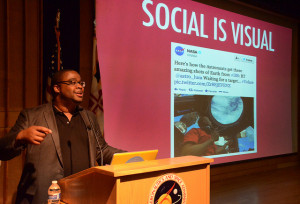What can nonprofits learn from Apple and Taylor Swift? A lot, actually. Continue reading
Public relations today includes a new set of rules. Earning coverage in print publications, such as industry journals, as well as interviews on TV and radio no longer drive PR efforts. Yes, traditional PR has value, but today’s PR is integrated and online. Continue reading
The beginning of 2020 has thrust our world into unexpected chaos. The effects of the COVID-19 pandemic have placed a tremendous challenge on all of us. None of us could have predicted this pandemic and the impact it would have on our lives, but if you think you can’t plan for a crisis — think again.
Addressing the worst-case scenario, or the potential of a disaster, is a topic that is not readily discussed. But smart and successful organizations talk about it — and make sure there’s a plan in place.
While you may not have the ability to predict or anticipate future events, you can create a general plan of action — a framework for responding to crisis situations. The most important thing in any crisis situation is to short-circuit denial. It’s a human trait when disaster strikes to go straight to thinking the situation isn’t actually happening, or that it may not be as bad as it seems.
The faster you take action and move past denial, the faster you can begin fixing the situation. Reacting quickly and efficiently makes all the difference – both to mitigate the crisis and to preserve your organization’s reputation. Done correctly and positioned positively, the way a crisis unfolds will dictate how your organization will be remembered.
Here are 10 tips from MagnifyGood that will help you navigate your way through a crisis:
Timely Response – As you identify an issue that needs immediate attention, your organization’s crisis plan will guide the sequence of events. Reaction time is crucial along with a carefully crafted approach.
Problem Solving – It is often overwhelming – even paralyzing – when you are faced with a big issue. First identify the problem. Then list the potential negative outcomes. If you systematically work through your list, you will find that your responses will flow and result in a manageable strategy that may work to your advantage.
Reacting vs. Defending – It is extremely important to respond to the issue as soon as possible. “No comment” or “We are not to blame” is viewed as an admission of guilt and an attack on others who may have an opposing point of view. Stay true to your response plan but also stay tuned to reactions to the plan and remain agile as the situation unfolds.
Manage Your Emotions – Your crisis plan should have a list of key team members who are assigned to collectively come up with a solution. If you are overly anxious, step back as others take the lead. Often times the team includes perspective from experts outside of the organization – from attorneys for legal to communications specialists.
Remain Vigilant and Informed – As things unfold, grab onto positive opportunities and respond to the unexpected. Do not assume that issuing a statement ends the crisis for your organization.
Focused Messaging – Use your organization’s talking points and elevator speech as you craft your messaging. Staying true to your brand and what you stand for should be woven into your response. Your actions may have averted the crisis. Face the issue head on and state how you intend to deal with the situation. Vague and cloaked answers are great fodder for negative discussions about your organization.
Transparency and Honesty Rule – Provide as much honest information as you can and accept responsibility if you know that your organization is at fault. Do not lie or respond with vague answers. If you are asked a question that you cannot answer, be truthful and say that you do not have the answer at this moment but will get the information and follow up. Make sure that you do follow up.
Honor the Mission and Vision – This is the reason why your organization exists. Take a 30,000-foot approach. This will help you stay positive and mission-driven as you negotiate your way through the process.
Be Accessible – Make sure that a representative is available at all times to respond to questions and that there are no barriers. Rather, there should be well-communicated ways to get information.
Get Staff and Stakeholders On Board – Immediately inform your board, staff and stakeholders of the issue and your planned response along with talking points that they can use. Clarity results in less confusion and speculation.
Staying focused on integrity during trying times begins with a well-structured and executed plan that remains agile. After all, your organization’s mission and contributions to society is the platform that will guide your honest and heartfelt response.
photo credit: the domino effect via photopin (license)
As a social sector communications agency, MagnifyGood specializes in elevating the marketing, PR, branding, advertising, and social media of nonprofits, foundations, and other mission-driven organizations. Looking to enhance your donor engagement, create compelling impact stories, establish a brand that aligns with your mission, or explore innovative strategies to connect with your community? Contact us here. Let’s magnify good together.
According to Google, 94 percent of people in United States with smartphones search for information on their phones. Continue reading
Editor’s Note: This is the fourth and final part of our series on connecting with low-income audiences.
In the final installment of our series about connecting with low-income audiences, we focus on meeting your beneficiaries where they are. Continue reading
Editor’s Note: This is the third part of our series on connecting with low-income audiences.
Your traditional bag of tricks (newspaper, magazine, tv, etc.) won’t get you very far when trying to reach a low-income audience. While it’s true that low income household consume more television than middle income households, traditional media channels do not offer the segmentation necessary to reach this audience. Continue reading
Editor’s Note: This is the second part of our series on connecting with low-income audiences.
Engaging the same people benefitting from your services or funding is a worthwhile component of any communications outreach effort. However, it’s not enough to merely list them among your various audiences – you must examine their media habits. Continue reading

Editor’s Note: This is the first part of our series on reaching low-income audiences.
We’re movement builders, cause communicators and sharers of “good.” It’s no surprise we believe in reaching people from all walks of life and finding ways to share their stories to Continue reading
Our children are our treasure. Each one deserves every chance to reach their promise.
But some, like Megan, struggle before they even get started.
Like 80% of low-income children, Megan can’t read well enough to keep up with the other kids her age. And the statistics Continue reading

Your organization’s goals and objectives light the path of where you’re headed. It’s the vision of your better world placed into the reality of what you have and the challenges you face.To realistically know where you’re going, it’s critical to spend time assessing where you are right now. Continue reading










